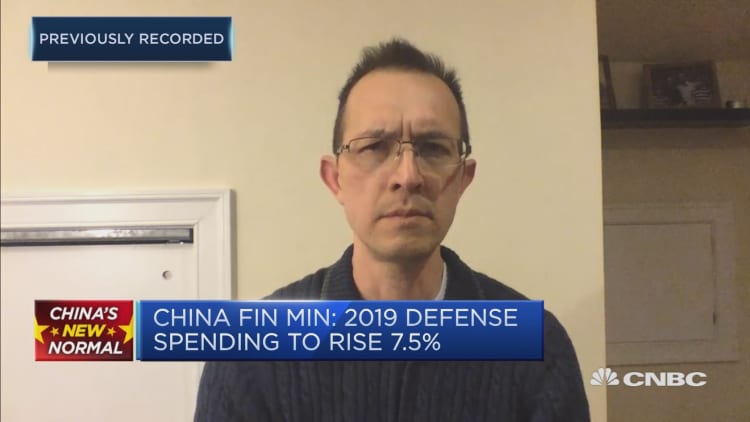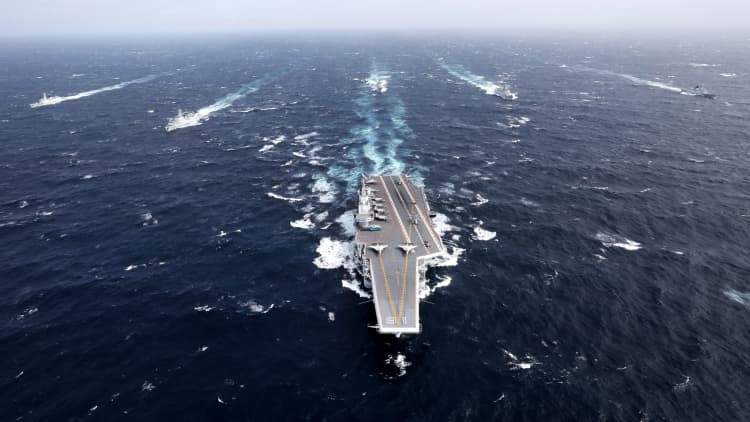China announced Tuesday that military spending will grow at a slower pace than last year, but one analyst cautioned that it should not be interpreted to mean that military tensions with the United States will ease.
At its annual parliamentary meeting, the National People's Congress, Beijing set its 2019 defense spending at 7.5 percent higher than a year ago — or 1.19 trillion yuan ($177.61 billion).
That's lower than the 8.1 percent growth in 2018 and far below double-digit increases of previous years — though analysts have long questioned how accurately the budget reflects actual spending.
Military tensions between the U.S. and China have been on the rise in recent years as Beijing takes a more assertive stance on territorial claims in the South China Sea and East China Sea, as well as over Taiwan — a self-ruled territory which Beijing claims as its own.
But slower growth in defense spending doesn't mean tensions with Washington have ceased, warned Timothy Heath, senior international defense researcher at U.S. think tank Rand Corporation.
In fact, the stated amount is less important than what it's used for, Heath told CNBC's "Squawk Box" on Tuesday.
Claims over South China Sea
China's military budget is closely watched for hints on its strategic intent in the region and beyond.
"We will implement the military strategy for the new era, strengthen military training under combat conditions, and firmly protect China's sovereignty, security and development interests," Premier Li Keqiang told parliament Tuesday.
The build-up of China's military capabilities has long rattled its neighbors. To counter Beijing's rising military might in the region, Washington has tens of thousands of troops stationed in its military bases in Japan and South Korea.
The U.S. Navy has also sailed war ships through the Taiwan Strait, and near fortified Chinese-controlled islands and reefs in the South China Sea — in a bid to show support for the right of freedom of navigation in international waters. China strongly criticizes those operations.

Heath said this year's military budget will likely be aimed at increasing the capability of China's military to "challenge U.S. power in Asia."
"So what this will mean in practice is, you're going to have a (Chinese military) with more lethal weaponry, greater ability to operate as a joint force and greater reach," Heath said. "And what that will probably do is exacerbate the tensions in the security domain."
To put things in perspective, China's military spending pales in comparison to the United States. President Donald Trump is expected to request a budget of about $750 billion for this year. Washington also largely outpaces Beijing in terms of equipment and weapons, such as the number of aircraft carriers — but China is keen to close that gap.
Heath also noted that China has been stepping up its military ambitions at sea and in cyber and outer space, and the country has been putting more of its resources into those domains.
"Undoubtedly some of the spending will be committed towards improving the (military's) offensive and defensive capabilities in the cyber, space and the more conventional domains," he said.
Cross-strait tensions
China has long sent mixed messages on its military ambitions, saying on the one hand they pose no external threat but vowing repeatedly, in the words of President Xi Jinping, to develop the capability to fight and win wars.
Heath said that China has steered its spending to obtain weapons including submarines, aircraft carriers, stealth aircraft and missiles.
"These are primarily designed to increase China's capabilities in any contingency regarding Taiwan, (the) South China Sea and East China Sea," he said.
Beijing has threatened before to use force against Taiwan if the self-ruled island moves toward formal independence.
Dane Chamorro, senior partner at Control Risks in Singapore, said that ensuring some kind of resolution to the issue of Taiwan's status is a key goal for President Xi who wants to cement his status as one of the country's most significant leaders.
"I'm not projecting that that means they are going to invade Taiwan," Chamorro said on CNBC's "Capital Connection."
"What I'm saying is that he will have to put in some kind of structure or mechanism or trajectory that's irreversible, so that at some point in the future Taiwan comes back to the mainland," Chamorro said.



